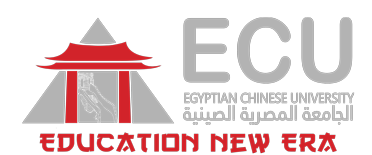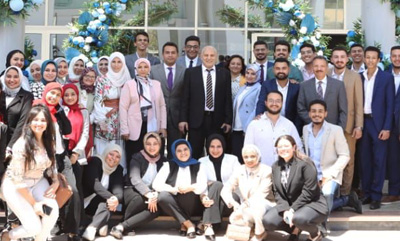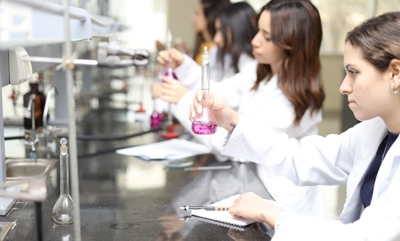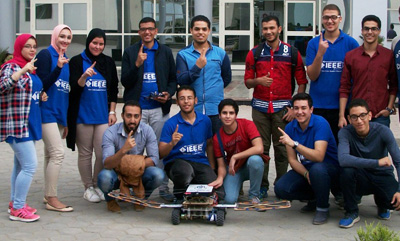
Strategic objectives and goals of the university’s research plan (2022-2026)
In line with the university’s vision, mission and strategic objectives, and within the framework of the specific governing values of the university’s work, the strategic goals and research plan objectives were set based on the university SWOT The research plan includes three strategic objectives, each containing a set of strategic objectives ranging from 4 to 7 goals, with a total of 17 strategic goals, as follows:
Strategic objectives of the research plan
1. Objective 1: scientific research coping with the global developments and economics considering the sustainable development and the productive university.
2. Objective 2: A distinguished researcher with a competitive spirit to positively contribute to the university image.
3. Objective 3: Partnership with local and international institutions to serve society problems and environmental development.
Objective 1: scientific research coping with the global developments and economics considering the sustainable development and the productive university.
1.1. Leveraging the university resources.
1.2. Focusing the research topics on the recent global trends, green research and sustainable development to protect the environment and its resources.
1.3. Contribute to innovation and creativity.
1.4. Integration of technology and information systems.
1.5. Supporting the international publication of the staff members.
1.6. Providing various postgraduate degrees.
1.7. Supporting postgraduate studies: diploma, master’s and phD in various disciplines.
Objective 2: A distinguished researcher with a competitive spirit to positively contribute to the university image.
2.1. Nurturing research competencies to create a distinguished research system.
2.2. Building the capacity for researchers and students
2.3. Strengthen the formation of research teams.
2.4. Supporting interdisciplinary research.
2.5. Supporting the marketing of scientific research.
2.6. Supporting the marketing of students’ projects.
Objective 3: Partnership with local and international institutions to serve society problems and environmental development.
3.1. Supporting the partnership with the local, regional and international community from research institutes, donors and attracting funded research projects
3.2. Supporting the partnership with the community to solve the problems and the university’s surrounding environment.
3.3. Marketing research and specialized research journals.
3.4. Strengthening the research cooperation with other universities, donors and institutions

Faculty of physical therapy
Faculty research plan is divided into two main categories: –
1- Basic science research plan
2- Applied and clinical research plan
1- Basic science research
1- Gait analysis
2- Exercise physiology
3- Motion analysis
4- Electrophysiology
5- Neurophysiology
6- Behavioral disorders
7- Artificial Intelligence Device Development
8- Infection control
9- TCM
10- Lung volumes
11- Orthotics
12- Athletes’ respiratory muscles
13- Pain modulation
14- Artificial intelligence and its applications in PT
2- Applied and clinical research
1- CVA
2- Muscular dystrophy
3- Muscle disease
4- Neuropathies
5- Osteoarthritis
6- Myocardial infarction
7- Lymphedema
8- Imbalances
9- Myositis and tendentious
10- Bladder disorders
11- Skin diseases
12- Varicose vein’s
13- Motor control
14- Spinal deformity
15- Headache
16- Weight reduction
17- Joint replacement
18- Wound healing
19- Sudden death of young athletes and underlying possible causes
20- Open heart surgery
21- Pelvic floor dysfunction
22- Diabetes

Faculty of Pharmacy and Drug Technology
The faculty’s research plan is derived from the five-year research plan of the University and is consistent with the Egypt strategy for Sustainable Development (Egypt Vision 2030) and the Executive Proposal for the National strategy for Science, Technology and Innovation (STI-EGY 2030).
These directions are based on two complementary key tracks:
Track 1:
Creating a stimulating and supportive environment for excellence and innovation in scientific research, establishing the development of a comprehensive community and the production of new knowledge that achieves international leadership. The desired consecutive axes are:
Axis I: Strategic objective: Supporting and developing human resources and developing infrastructure to promote scientific research.
Axis II: Strategic objective: Improving the amplitude of scientific research (basic, interdisciplinary, future research and social) to achieve a high level of excellence that contributes to achieving regional and international leadership.
Axis III: Strategic objective: Funding scientific research and linking it to the industry and development plans and satisfy society needs, and strengthen partnership with different sectors.
Track 2:
Harnessing knowledge and leveraging technology to contribute to economic and social development.
The desired axes are:
Axis I: Health
Strategic objective: A healthy and safe life for all citizens for prosperity, well-being, happiness as well as social and economic development.
Axis II: Environment
Strategic objective: Continuous improvement of quality of life, raising awareness about protecting nature and reducing the impact of climate change aiming to provide a clean, safe and sustainable environment for future generations and stimulating the green economy.
Axis III: Technological Applications and Future Sciences
Strategic objective: Research and development of interdisciplinary and future sciences and technologies aiming to be in readiness for the future. In order to achieve that, the research directions of the faculty can be determinedIn the following:
- Discovery and formulation of active agents (natural /synthetic) in novel delivery system and the use of modern techniques that help in the evaluation, determination their theranostic efficacy in addition to the treatment of chronic, endemic, epidemic diseases and tumors.
- Restorative knowledge of the newly widespread diseases, raise the community health awareness and study the economic and social effects of these diseases.
- Extensive use of green chemistry to provide a clean, safe and sustainable environment for future generations.
- Use of targeted drugs based on modern applied technology techniques such as nanotechnology, genetic engineering and stem cells in the treatment of diseases.
- Strengthen community partnership with different health sectors and encourage pharmaceutical companies with scientific research to solve the pharmaceutical industrial problems using modern techniques.

Faculty of Engineering and Technology
The faculty’s research plan aims to support scientific research and innovation which is based on developing the system and quality of the scientific research according to the national and international strategies for science, technology and innovation. In addition, to focusing on the interest in activating the principles of sustainability and productive thinking, enhancing current and potential areas of research excellence, developing programs for graduate studies, enhancing scientific research skills, developing research laboratories, and providing material resources.
Thus, these resources are used to support researchers for scientific competition, creativity and innovation, and marketing the outputs of scientific research by strengthening international cooperation and effective partnership with local and international institutions.
Research Dimensions within the Framework of the National Strategies for Science, Technology and Innovation until 2030
The research plan achieves the mission of the college through the development of a system and quality of scientific research and innovation, and it is linked to the strategic plan of the state, which aims to support economic and social development and solve national problems. The faculty is committed to the ethics of scientific research and the principles applicable in academic institutions. A plan has been prepared for compatibility with the national strategies for science, technology and innovation 2030, with a priority given to the following research dimensions:
- The first dimension: Energy
- The second dimension: Water
- The third dimension: Agriculture and food
- The fourth dimension: Environment
- The fifth dimension: Technological applications and future sciences
- The sixth dimension: Strategic industries
- The seventh dimension: Information technology, communications, and space
- The eighth dimension: Education is national security